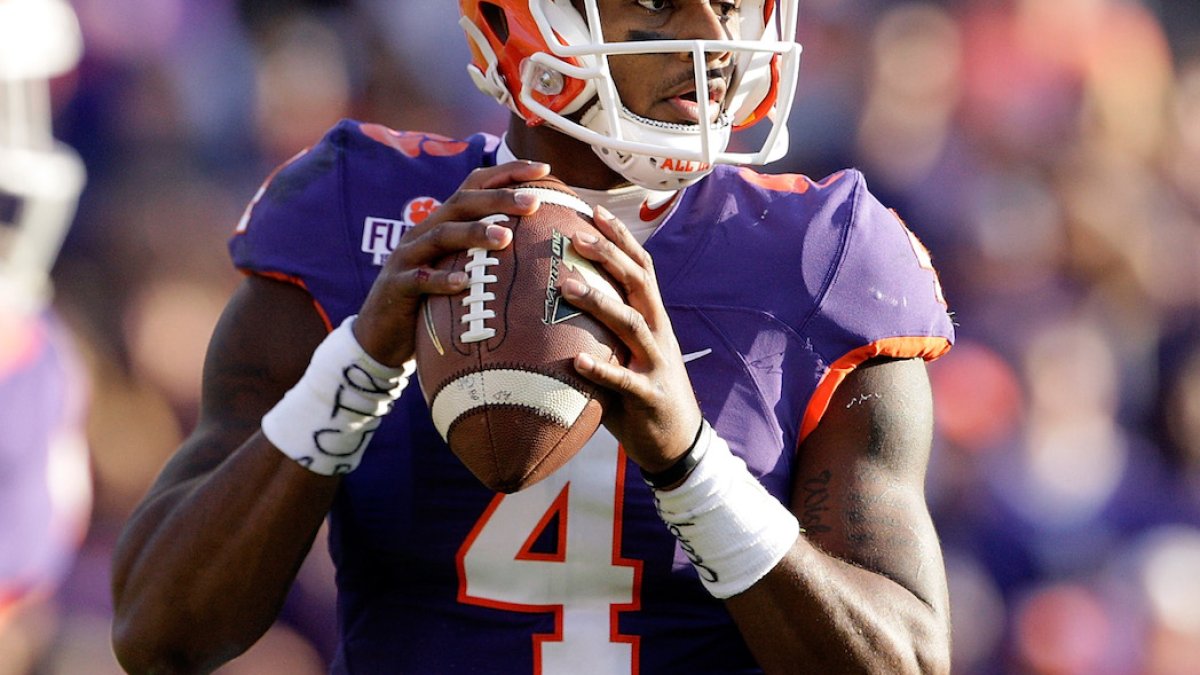Clemson's Deshaun Watson is currently one of the best college quarterbacks in the country, and is the catalyst behind the success of the Tigers. Entering the College Football Playoff semifinal, he has earned the third-highest grade among QBs this season, at 90.4.
In the first round of the College Football Playoff, he takes on an Ohio State team whose strength is its defense. Watson showcases three major attributes when throwing the ball: his deep-ball accuracy, his ability to handle pressure, and his ability to make quick reads. He will need to use all three skills effectively in order to beat the Buckeyes on Saturday. Let’s take a look:
1. Deshaun Waston was the sixth-most-accurate QB on deep targets this season.
Being able to stretch the field does wonders for an offense, and Watson is one of the best in the nation at throwing deep. Among QBs with at least 50 deep attempts (passes traveling 20-plus yards in air), Watson ranks sixth in adjusted completion rate, at 49.4 percent, and his numbers improved as the season went on.
Watson won’t have it easy against the Buckeyes, however. On deep routes, QBs have thrown 59 passes of over 20 yards versus Ohio State, completing only 12 for 378 yards, two touchdowns, and six picks. Of all the deep throws, Watson is most likely to attack the Ohio State secondary with go-routes. Watson has thrown a go-route on 84 of his 470 pass attempts, the most of any route.
On the season, quarterbacks have attempted 58 go-routes versus the Buckeyes, completing only 15 for 386 yards, five touchdowns, four interceptions, with three drops with a passer rating of 54.8. But these numbers may be a bit inflated due to the lack of elite QB play in the Big Ten. The best quarterback the Buckeyes played all year was Oklahoma’s Baker Mayfield, who completed three of four passes over 20 yards for 149 yards and two scores against them. Watson may be able to find similar success to Mayfield, but he will need to pick his spots wisely.
2. Watson's adjusted completion rate under pressure improved by 14 percent between the 2015 and 2016 seasons.
Watson struggled handling pressure in 2015, but he has improved significantly in 2016. He has shown impressive growth and poise in 2016 when pressured, something that was a concern for him entering the season. His numbers improved across the board, with his sack rate dropping by 2 percent and his adjusted completion rate improving by 14 percent.
Watson will have an opportunity to show just how good he is at handling pressure as he takes on an Ohio State team that is used to pressuring the QB. The Buckeyes recorded a pressure rate of 37 percent, which is third-best in the Big Ten. PFF ranks Ohio State’s pass-rush unit as the fifth-best in the entire country, and four of the Buckeyes’ five defensive ends rank in the top 31 in pass-rushing productivity (PRP) out of 179 qualifying DEs.
3. Watson's average time to attempt was 2.11 seconds in 2016, the sixth-fastest time in the nation.
While time in the pocket will differ from team to team, being able to get rid of the ball quickly is essential to the success of any quarterback. Watson’s average time to attempt this year was 2.11 seconds, sixth-fastest in the nation. This could be used as an argument that Watson was predetermining his reads and throwing it to the first receiver in his progressions, but when you look closer at his numbers, you see that he actually improved when he took more time in the pocket and had to go to his second, third, and fourth reads.

As noted earlier, Ohio State has been able to get substantial pressure on over 37 percent of passing plays. Often the best way to beat a pass-rush is utilize a quick passing game.
Of the four quarterbacks who play for teams currently ranked in the top 25 that also played Ohio State this season (Michigan's Wilton Speight, Penn State's Trace McSorely, Wisconsin's Alex Hornibrook, and Oklahoma's Baker Mayfield), each was able to find success when throwing the ball in 2.5 seconds or less. Only Michigan’s Wilton Speight had a QB rating below 100.0 on such throws, at 97.7. Look for Watson’s natural ability to get rid of the ball quickly to be a big advantage for Clemson. He should be able to replicate the success of the other top QBs who played the Buckeyes and use the quick passing game as a weapon for the Tigers.
Ohio State’s secondary is loaded with talent, including two of the top cornerbacks in the country in Marshon Lattimore and Gareon Conley. Their matchup with Clemson’s Mike Williams—the No. 14 ranked WR in PFF's overall grades—will be a great one.
There may be more opportunities, however, for Watson to isolate matchups with tight end Jordan Leggett and slot receivers Artavis Scott and Hunter Renfrow against Chris Worley, who covers frequently out of the slot, and safety Damon Webb. Both Buckeyes defenders have struggled some in coverage, and getting the ball out quickly to those playmakers may play to Watson’s advantage.
This semifinal matchup should be excellent, and Deshaun Watson’s level of success should go a long way toward determining which team advances to the national title game.



 © 2024 PFF - all rights reserved.
© 2024 PFF - all rights reserved.